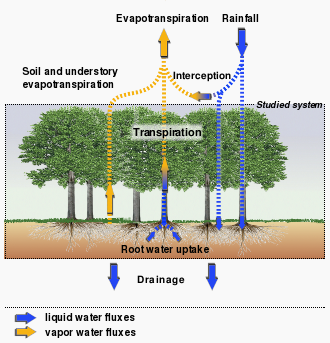
BILJOU
Forest water balance model
 - Silva Joint Research Unit
- Silva Joint Research Unit
Water Balance
Definition
To accurately establish mass balance, in this case for water, it is necessary to:
- Define a physical system
- Quantify the total inflow and outflow of water fluxes on a fixed time scale
- Apply the water balance equation as follows:
Selecting the system
Our water balance model is designed to account for a homogeneous area, generally one that measures 1 m2 or 1 square hectare. This system includes tree crowns and all soil layers containing root systems. Water fluxes are expressed in mm (1 mm = 1 L/m2).
In-flowing water fluxes
This is largely defined as precipitation, but capillary rises
should also be considered, notably if there is a water table.
 Lateral water fluxes (run-off or lateral drainage) might also exist, but the model will only consider conditions in which
the in-flowing and out-flowing water fluxes for the plot are equal.
Lateral water fluxes (run-off or lateral drainage) might also exist, but the model will only consider conditions in which
the in-flowing and out-flowing water fluxes for the plot are equal.
Out-flowing water fluxes
- Tree transpiration (T) is the transfer of water absorbed from the soil through fine roots to the leaves via the tree's xylem tissue,
- Interception of precipitation (In) represents the water flux evaporated from the leaf surface during and just following rainfall. It should be noted that snow can also be intercepted followed by partial evaporation (sublimation);
- Soil evaporation and transpiration in the herbaceous sub layer (Eu),
- Actual evapotranspiration (AET) is the sum of the three water fluxes described above:
AET = T + In + Eu - Drainage (D) below the root soil layer. This flux supplies aquifers or rivers, depending on the sites hydrological characteristics.
The results of these different types of fluxes either increase or decrease the total water content of the system found essentially in the soil (1).
Examples and supporting data
-
Example of a beech forest in the Lorraine region of France comparing water balance fluxes taken during a wet
year (2006) and during a dry year (2003). Annual values are shown in mm.
Water fluxes Wet year (2006) Dry year (2003) Rainfall 1005 661 Tree transpiration 220 197 Rainfall interception 116 96 Soil and herbaceous sublayer evaporation 45 46 Drainage 623 322 -
Example of temporal variation in a beech forest in lowlands over a period of two years showing the leaf area index, tree transpiration (T),
actual evapotranspiration (AET), daily rainfall levels and relative water content of the soil (REW). Granier et al. (2000)

Useful references
![]() Peiffer M, Le Goff N, Nys C, Ottorini J-M, Granier A (2005) Bilan d’eau, de carbone et croissances comparées de deux hêtraies de plaine. Revue forestière française, LVII, 205-216.
Peiffer M, Le Goff N, Nys C, Ottorini J-M, Granier A (2005) Bilan d’eau, de carbone et croissances comparées de deux hêtraies de plaine. Revue forestière française, LVII, 205-216.
![]() Granier A, Badeau V, Bréda N (1995) Modélisation du bilan hydrique des peuplements forestiers. Revue forestière française, XLVII, 59-68.
Granier A, Badeau V, Bréda N (1995) Modélisation du bilan hydrique des peuplements forestiers. Revue forestière française, XLVII, 59-68.
![]() Aussenac G, Boulangeat C (1980) Interception des précipitations et évapotranspiration réelle dans des peuplements de feuillu (Fagus silvatica L.)et de résineux (Pseudotsuga menziesii (Mirb) Franco). Ann. Sc forest., 37(2), 91-107.
Aussenac G, Boulangeat C (1980) Interception des précipitations et évapotranspiration réelle dans des peuplements de feuillu (Fagus silvatica L.)et de résineux (Pseudotsuga menziesii (Mirb) Franco). Ann. Sc forest., 37(2), 91-107.
![]() Bréda N, Huc R, Granier A, Dreyer E (2006) Temperate forest trees and stands under severe drought: a
review of ecophysiological responses, adaptation
processes and long-term consequences. Annals of Forest Science, 63, 625–644.
Bréda N, Huc R, Granier A, Dreyer E (2006) Temperate forest trees and stands under severe drought: a
review of ecophysiological responses, adaptation
processes and long-term consequences. Annals of Forest Science, 63, 625–644.
![]() Granier A, Biron P, Lemoine D (2000) Water balance, transpiration and canopy conductance in two beech stands.
Agricultural and Forest Meteorology, 100, 291-308.
Granier A, Biron P, Lemoine D (2000) Water balance, transpiration and canopy conductance in two beech stands.
Agricultural and Forest Meteorology, 100, 291-308.
 Courbet F, Doussan C, Limousin J-M, Martin-St Paul N, Simioni G (2022) Forêt et changement climatique - Comprendre et modéliser le fonctionnement hydrique des arbres. Editions Quae, collection Synthèses, 144 p.
Courbet F, Doussan C, Limousin J-M, Martin-St Paul N, Simioni G (2022) Forêt et changement climatique - Comprendre et modéliser le fonctionnement hydrique des arbres. Editions Quae, collection Synthèses, 144 p.
(1) but not exclusively from soil: the different organs of the tree, mainly the sapwood of the trunk and to a lesser extent, the branches and roots, can act as an additional source of water in the case of drought. When the water stress is alleviated, this phenomenon can act in reverse.

